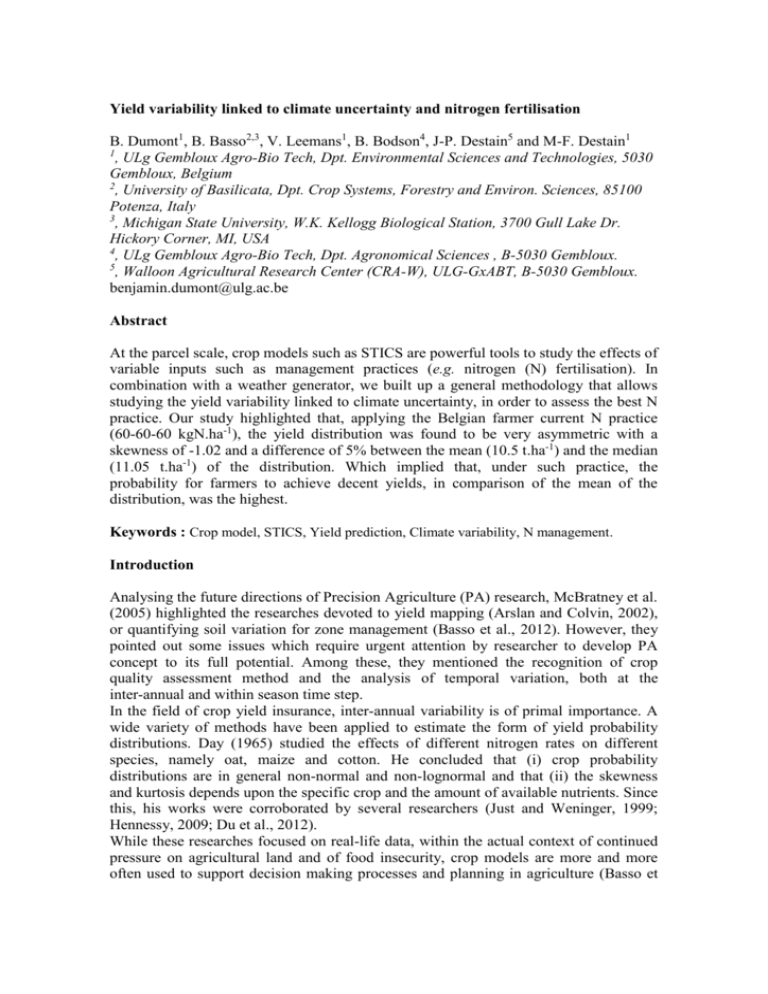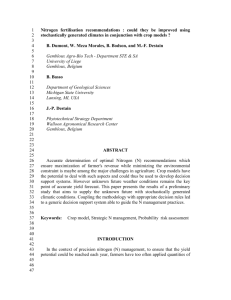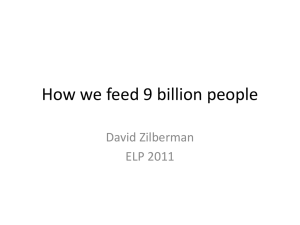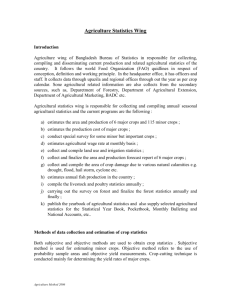A MODEL FOR WHEAT YIELD PREDICTION BASED ON
advertisement

Yield variability linked to climate uncertainty and nitrogen fertilisation
B. Dumont1, B. Basso2,3, V. Leemans1, B. Bodson4, J-P. Destain5 and M-F. Destain1
1
, ULg Gembloux Agro-Bio Tech, Dpt. Environmental Sciences and Technologies, 5030
Gembloux, Belgium
2
, University of Basilicata, Dpt. Crop Systems, Forestry and Environ. Sciences, 85100
Potenza, Italy
3
, Michigan State University, W.K. Kellogg Biological Station, 3700 Gull Lake Dr.
Hickory Corner, MI, USA
4
, ULg Gembloux Agro-Bio Tech, Dpt. Agronomical Sciences , B-5030 Gembloux.
5
, Walloon Agricultural Research Center (CRA-W), ULG-GxABT, B-5030 Gembloux.
benjamin.dumont@ulg.ac.be
Abstract
At the parcel scale, crop models such as STICS are powerful tools to study the effects of
variable inputs such as management practices (e.g. nitrogen (N) fertilisation). In
combination with a weather generator, we built up a general methodology that allows
studying the yield variability linked to climate uncertainty, in order to assess the best N
practice. Our study highlighted that, applying the Belgian farmer current N practice
(60-60-60 kgN.ha-1), the yield distribution was found to be very asymmetric with a
skewness of -1.02 and a difference of 5% between the mean (10.5 t.ha-1) and the median
(11.05 t.ha-1) of the distribution. Which implied that, under such practice, the
probability for farmers to achieve decent yields, in comparison of the mean of the
distribution, was the highest.
Keywords : Crop model, STICS, Yield prediction, Climate variability, N management.
Introduction
Analysing the future directions of Precision Agriculture (PA) research, McBratney et al.
(2005) highlighted the researches devoted to yield mapping (Arslan and Colvin, 2002),
or quantifying soil variation for zone management (Basso et al., 2012). However, they
pointed out some issues which require urgent attention by researcher to develop PA
concept to its full potential. Among these, they mentioned the recognition of crop
quality assessment method and the analysis of temporal variation, both at the
inter-annual and within season time step.
In the field of crop yield insurance, inter-annual variability is of primal importance. A
wide variety of methods have been applied to estimate the form of yield probability
distributions. Day (1965) studied the effects of different nitrogen rates on different
species, namely oat, maize and cotton. He concluded that (i) crop probability
distributions are in general non-normal and non-lognormal and that (ii) the skewness
and kurtosis depends upon the specific crop and the amount of available nutrients. Since
this, his works were corroborated by several researchers (Just and Weninger, 1999;
Hennessy, 2009; Du et al., 2012).
While these researches focused on real-life data, within the actual context of continued
pressure on agricultural land and of food insecurity, crop models are more and more
often used to support decision making processes and planning in agriculture (Basso et
al., 2011; Ewert et al., 2011). Indeed, they are powerful tools to study the effects of
variable inputs on harvestable organs, such as management practices, agroenvironmental conditions (e.g., soil characteristics) and weather events.
In this way, crop models appear as tools dedicated to assess the end-season crop-quality.
However, in the particular field research of nitrogen (N) management, Basso et al.
(2012) stated that the complexity of decision making was linked to the fact that the
decision about the amount of N fertilizer to apply had to be taken without any prior
knowledge of future weather conditions. To cope with such uncertainty, previous author
(Basso et al., 2012) analysed the model cumulative probability under different
monitored past climate scenarios. A methodologically more consistent approach to
study the effects of climatic variability on the simulated crop yield is to use a stochastic
weather generator, instead of historical data which are often not numerous (Semenov
and Porter, 1995; Lawless and Semenov, 2005).
In this paper, we propose a new general methodology to assess the impact of N fertiliser
rate on crop yield, using crop models. As an integration of previous knowledge (Day,
1965 ; Lawless and Semenov, 2005 ; Basso et al. 2012), the methodology constitute an
new point of view to temporal and inter-annual analysis. It relies on a database of
stochastically generated climates, which ensure the exploration of the most
advantageous and disadvantageous climate conditions, in combination with a sitespecific calibrated crop model, to assess the optimal N rate.
Materials and methods
Case study
Field experiments were carried out to measure a winter wheat crop response (Triticum
aestivum L., cultivar Julius) to the Belgian temperate climate, more precisely in the
Hesbaye Region (loamy soil conditions), and to different nitrogen fertilisation levels,
ranging from zero to 240 kgN.ha-1.
Three successive years (2008-11) with highly contrasting weather were monitored.
During the season 2008-2009, yields were very high. The exceptionally good weather
conditions and sufficient nitrogen nutrition level allow to imagine that the yields were
close to the optimum allowed by the cultivar. The seasons 2009-2010 and 2010-2011
were known to induce deep water stresses and were characterised by important yield
losses. During the last two seasons, the stresses did not appear at the same crop stages.
Regular biomass growth reference measurements (LAI, total biomass and grain yield)
and continuously monitored environmental measurements (climatic data and soil
moisture) were performed over the growing seasons.
Moreover, a 30-year weather database provided by a reference meteorological station
(Ernage Weather Station), located 4km from the field, was available for this study.
Crop model
The soil-crop model STICS was used in this study. A wide literature can be found
concerning the STICS model formalisms and the way it simulates yield (Brisson et al.,
2003; Brisson et al., 2009). The STICS model requires daily weather climatic inputs,
namely minimum and maximum temperatures, total radiation and total rainfall. In the
case of more complex formalisms about potential evapotranspiration calculations, the
wind speed and vapour pressure are needed.
The STICS model parameterisation, involving calibration and validation, was
performed on the three-year database previously presented, using inverse modelling
techniques (Vrugt et al., 2009). The parameters of the model were adjusted to accurately
simulate the different components of the yield (i.e. biomass, grain yield and protein
content) under the different nitrogen fertilisation levels. The contrasted years, in terms
of climate conditions and corresponding yields, were used to parameterise the water and
thermal stresses affecting the simulated dynamic biomass growth.
Original weather database and climate variability
For the experimental recorded crop seasons, data acquired by an in-field sensors
network were compared with the data issued from the reference meteorological station.
For each climatic variable, the results were found to be in good accordance. Provided
that the input data used to calibrate the model were representative enough to ensure
robustness, the STICS model could be run on the 30-year (1980-2009) Ernage weather
database.
This database was thus analysed with the LARS-WG (Semenov and Barrow, 2002;
Lawless and Semenov, 2005) to compute the set of parameters representing the
experimental site. These characteristic values were then used to generate an ensemble of
stochastic synthetic weather time-series representative of the climate conditions in the
area. A climate database ensemble of 300 years was derived to ensure a stability of the
simulated mean yield (Lawless and Semenov, 2005). The so-created ensemble of
synthetic weather time-series was used as input of the crop model STICS.
Nitrogen management strategies
In Belgium, the farmer current N fertilizer practice is to split a total 180 kgN.ha-1 dose
in three equal fractions, applied respectively at tillering (Zadoks stage 23), redress
(Zadoks stage 29) and last-leaf (Zadoks stage 39) stages. This practice will be used as
reference and compared to different levels of N fertilisation, also applied in three
equivalent fractions, at tillering, redress and last-leaf stages, with an increasing N step
of 10 kgN.ha-1, ranging from 0 to 300 kgN.ha-1 (3×100 kgN.ha-1) (Table 1).
To simplify the simulation process, as first assumption, the same management
techniques were applied to each simulation, in terms of sowing date (Julian Day 295)
and of fertilisation dates (Julian days 445, 475 and 508).
Table 1. Fertilisation rate for the different N strategies.
Treat. #
Fertilisation level (in kgN.ha-1)
Til. (Z23) Red.(Z29) L.Leaf (Z39) Total
T1
T2
...
T11
0
10
...
100
0
10
...
100
0
10
...
100
0
30
...
300
The Pearson system and coefficients
Pearson developed an alternative system of probability density functions that take a
wide variety of forms (Day, 1965; Pearson, 1895). In this paper, we will focus on the
type I distribution, for which random variable has a finite range (Eq. 1).
The different types of distributions can also be identified independently from their mean
and variance, rather referring to their asymmetry (skewness) and flattening (kurtosis)
parameters (Eq. 2)
k.( x 1 ) 1 ( x 2 ) 2
f x
0
, 1 y 2
, y 1
or 2 y
(1)
where α1 and α2 are the boundaries of the distribution and γ1 and γ2 are the coefficients
of shape.
Skewness
m3
m
33
3/ 2
m2
m
m
Kurtosis 42 44
m2
(2)
Where mx is the momentum of order x, and σ is the standard deviation. The squaredskewness is typically known as the β1 Pearson parameter, and the kurtosis is also
typically found under the β2 Pearson parameter denomination. Since it is signed, and
thus gives the orientation of the asymmetry, the skewness parameter was preferred in
this paper.
Specificities and genericity of the method
It is really important to remind that, although the methodology is generic, the results
presented here remains site-specific. First, the model was parameterised and calibrated
on a specific soil type and for a specific crop culture. Furthermore, the 30-years original
weather database, and the so-derivate 300 years climatic conditions, are also
representative of the climatic conditions in this specific area.
In this paper we focus on the grain yield (GY) simulations obtained with the STICS
model, but being generic the procedure could be applied on any other model or model
output, e.g. the grain protein content.
Results and discussions
General assessment of the distributions
Fig.1. provides an insight, as a boxplots representation, of the results obtained at the end
of the simulation process. To discuss these results in detail, two fertilisation levels are
presented, respectively the 0-0-0 kgN.ha-1 (T1), the 60-60-60 kgN.ha-1 (T7) strategies,
for which both the cumulative distribution function (CDF) and the probability density
function (PDF) are presented (Fig.2)
It first appeared that the Type I distribution was particularly suited to describe the yield
distribution (Fig.2). The distribution of the T1 treatment seemed very close to a normal
distribution (Fig.2). Each increase in N supply allowed the yield to increase, both in
mean and median values (Fig.1 and 2), but also tended to induce asymmetry among the
distribution (Fig.2), with a median value situated closer to the highest yields than the
lowest. This induced, in return, a negative skewness (Fig.3), with a median value
superior to the mean (Fig.2 and 3).
Skewness and kurtosis of the distributions
A first insight into Fig. 3 led to the conclusion that the skewness and kurtosis parameters
evolved in opposite directions, in accordance with the theory. The more pronounced the
dissymmetry, the more spread/flattened the curve.
The non-application of nitrogen exhibited a distribution with close-to-zero skewness
(-0.002) and a kurtosis close to three. This was pretty close to the Gaussian distribution
(skewness and kurtosis of 0 and 3 respectively).
Figure 1. Boxplot analysis of the different N fertilisation strategies.
Figure 2. Cumulative distribution function (CDF) and probability density function
(PDF) corresponding to the treatment T1 (up) and T7 (down). Comparison of the
numerical-experimental curve out of the 300 simulations (grey line) and the computed
Type I distribution of Pearson System (black line). Representation of percentile 50
(horizontal thick black line) and percentiles 2.5 and 97.5 (horizontal thick grey line).
The vertical black line represents the mean of the distribution.
The 60-60-60 kgN.ha-1 treatment led to the highest degree of asymmetry, with a
skewness value of -1.02 and a kurtosis close to 3.85. The asymmetry was reduced with
higher N practices, therefore characterised by less negative skewness parameters, to
reach a value of -0.83 at 100-100-100 kgN.ha-1.
At the farmer current N practice, a difference of 5% between the mean (10.5 t.ha-1) and
the median (11.05 t.ha-1) of the distribution was observed.
Figure 3. Skewness and Kurtosis of the different N fertilisation strategies.
Assessing the normality of the distributions
In the face of the results obtained on the skewness and kurtosis parameter values, the
normality of the distributions was assessed using a Kolmogorov-Smirnov test (Table 2).
It appeared that the distribution could be considered as being normal up to a
10-10-10 kgN.ha-1 treatment. As soon as the total amount of 60 kgN.ha-1
(20-20-20 kgN.ha-1) was provided to the crop, the yield distribution was considered as
being asymmetric.
The equivalence of the mean of the distributions were analysed the one with the other,
using an ANOVA test (results not shown). In a global way, each additional N
fertilisation level led to, at least, significant ('*') higher grain yields. However, a N
management strategy with N supply higher than 90-90-90 kgN.ha-1 (T10) did not
improve significantly the expected mean; treatment T9-T10 and T10-T11 were found
statistically equal. This was confirmed by Fig. 1 analysis, where the expected yield
seemed to reached a plateau.
Table 2. Evaluation of the normality of the distribution, using a Kolmogorov-Smirnov
test (p-value and significance level).
T#
T1
T2
T3
T4
T5
T6
T7
T8
T9
T10
T11
p-val. 0.766 0.339 0.023 0.017 0.018 0.013 0.007 0.006 0.002 0.004 0.003
Signif.
*
*
*
*
**
**
**
**
**
Return time of yields
Finally, at this stage of the research, the proposed methodology was extended and used
to assess the probability of occurrence of yields, in other words, to estimate the
probability encountered by the farmers to achieve a determined amount of yield. The
different N practices were thus analysed in terms of yield associated with a given return
time, e.g. by calculating the yield obtained 9 years out of 10 (Table 3).
These characteristic values were easily obtained by computing the yield associated with
the 1-α probability, were α is the probability associated with the return time (e.g. 0.75
when the return time is 3 years out of 4).
In this way, at the current N practice (T7), in 9 years out of 10, the farmer would at least
achieve a grain yield of 7.26 t.ha-1. In the same way, 3 years out of 4, the expected yield
should be at least of 9.21 t.ha-1 for the same N management.
Table 3. Yields (t.ha-1) associated with a given return time (probability of occurrence),
respectively 3 years out of 4 (p=0.75) and 9 years out of 10 (p=0.90)
T#
T1
p=0.75 3.56
p=0.90 3.00
T2
4.61
3.83
T3
5.65
4.65
T4
6.70
5.44
T5
7.63
6.11
T6
8.48
6.78
T7
9.21
7.26
T8
9.71
7.63
T9
10.1
7.81
T10
10.4
8.13
T11
10.6
8.27
Conclusions
As a specific conclusion of this study, we think that the shape of a distribution,
characterised by its skewness and kurtosis, is of primal importance, at the same level (or
even more) than its mean, and its standard deviation. In this way, the type I distribution
of the Pearson system was found as a systematically good predictor of the crop model
answer. Our analysis showed that without fertilisation the crop model behaviour seemed
to exhibit a Gaussian distribution in response to the climatic inputs, here considered as
random input variables.
The different increasing N practices induced a behaviour characterised by a negative
skewness in comparison of the T1 treatment (0-0-0 kgN.ha-1), i.e. exhibiting a median
value superior to the mean of the distribution. Moreover, the farmer current N practice
(60-60-60 kgN.ha-1) exhibited the highest degree of asymmetry, i.e. with the lowest
skewness value. This practice is therefore the one that most increases the probability of
obtaining a final yield that is higher than the mean of the expected distribution.
In front of the results, the methodology has a real potential to cope with new issues of
PA concept, namely the consideration of temporal variation and the crop quality
assessment. Furthermore, provided that the crop model answer is correctly validated for
a given crop cultivated under different soil types within the same field, the method
would allow to determine the best N practice to perform zone management. Since it is
based on a high number of stochastically generated climate, it includes the study of the
yield uncertainty link to inter-annual climate variability. For all enounced reasons, the
method appear as an interesting tool to develop decision support systems.
Acknowledgements
The authors would like to thank the SPW-DGO3 for its financial support. The authors
would also like to thank the OptimiSTICS team that allowed them to use the Matlab
running code of the STICS model. Finally, the authors are very grateful to CRA-w,
especially the department 'Agriculture et milieu naturel' for the Ernage station climate
database that they provided.
References
Arslan, S., Colvin, T. (2002). Grain Yield Mapping: Yield Sensing, Yield
Reconstruction, and Errors. Precision Agriculture, 3(2), 135-154
Basso, B., Ritchie, J. T., Cammarano, D., & Sartori, L. (2011). A strategic and tactical
management approach to select optimal N fertilizer rates for wheat in a spatially
variable field. European Journal of Agronomy, 35(4), 215-222,
doi:10.1016/j.eja.2011.06.004.
Basso, B., Sartori, L., Cammarano, D., Fiorentino, C., Grace, P. R., Fountas, S., et al.
(2012). Environmental and economic evaluation of N fertilizer rates in a maize
crop in Italy: A spatial and temporal analysis using crop models. Biosystems
Engineering, 113(2), 103-111, doi:10.1016/j.biosystemseng.2012.06.012.
Brisson, N., Gary, C., Justes, E., Roche, R., Mary, B., Ripoche, D., et al. (2003). An
overview of the crop model stics. European Journal of Agronomy, 18(3–4), 309332, doi:10.1016/s1161-0301(02)00110-7.
Brisson, N., Launay, M., Mary, B., & Beaudoin, N. (2009). Conceptual basis,
formalisations and parameterization of the STICS crop model: Editions Quae.
Collection Update Sciences and technologies.
Day, R.H. (1965). Probability distributions of field crop yields. Journal of Farm
Economics, 47(3), 713-741.
Du, X., Hennessy, D., & Yu, C. (2012). Testing Day's conjecture that more nitrogen
decreases crop yield skewness. American Journal of Agricultural Economics,
94(1), 225-237.
Ewert, F., van Ittersum, M. K., Heckelei, T., Therond, O., Bezlepkina, I., & Andersen,
E. (2011). Scale changes and model linking methods for integrated assessment of
agri-environmental systems. Agriculture, Ecosystems & Environment, 142(1–2),
6-17, doi:10.1016/j.agee.2011.05.016.
Hennessy, D. A. (2009). Crop yield skewness under law of the minimum technology.
American Journal of Agricultural Economics, 91(1), 197-208, doi:10.1111/j.14678276.2008.01181.x.
Just, R. E., & Weninger, Q. (1999). Are crop yields normally distributed? American
Journal of Agricultural Economics, 81(2), 287-304, doi:10.2307/1244582.
Lawless, C., & Semenov, M. A. (2005). Assessing lead-time for predicting wheat
growth using a crop simulation model. Agricultural and Forest Meteorology,
135(1–4), 302-313, doi:10.1016/j.agrformet.2006.01.002.
McBratney, A., Whelan, B., Ancev, T., Bouma, J. (2005). Future Directions of
Precision Agriculture. Precision Agriculture, 6(1), 7-23
Pearson, K. (1895). Contributions to the Mathematical Theory of Evolution, II : Skew
variation in homogeneous material. Philosophical Transactions of the Royal
Society of London - ARRAY, 186, 343-414.
Semenov, M., & Porter, J. (1995). Climatic variability and the modelling of crop yields.
Agricultural and Forest Meteorology, 73(3–4), 265-283, doi:10.1016/01681923(94)05078-k.
Semenov, M. A., & Barrow, E. M. (2002). LARS-WG - A stochastic weather generator
for use in climate impact studies. User manual, version 3.0, August 2002. Tech.
rep., Rothamsted Research, Harpenden, Hertfordshire, AL5 2JQ, UK.
Vrugt, J. A., Braak, C. J. F. t., Diks, C. G. H., Robinson, B. A., Hyman, J. M., &
Higdon, D. (2009). Accelerating Markov chain Monte Carlo simulation by
differential evolution with self-adaptive randomized subspace sampling.
International Journal of Nonlinear Sciences and Numerical Simulation, 10(3),
273-290.





